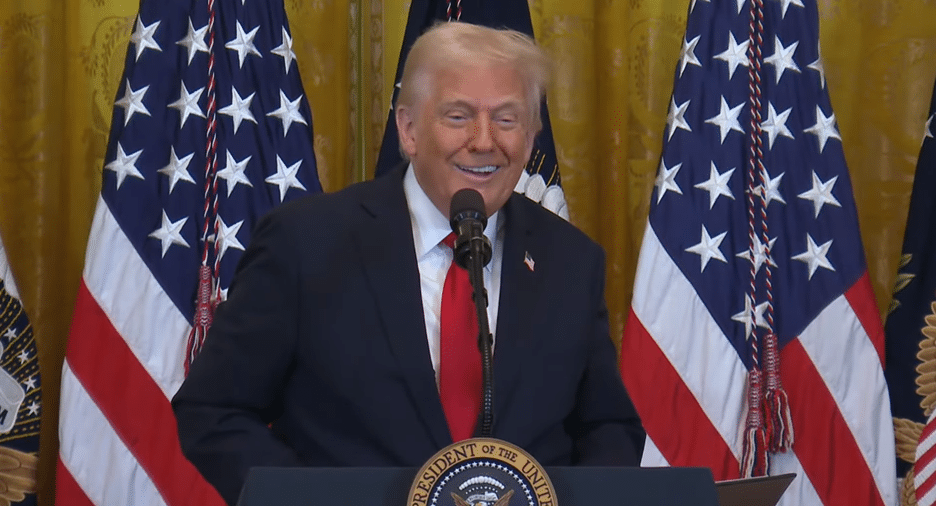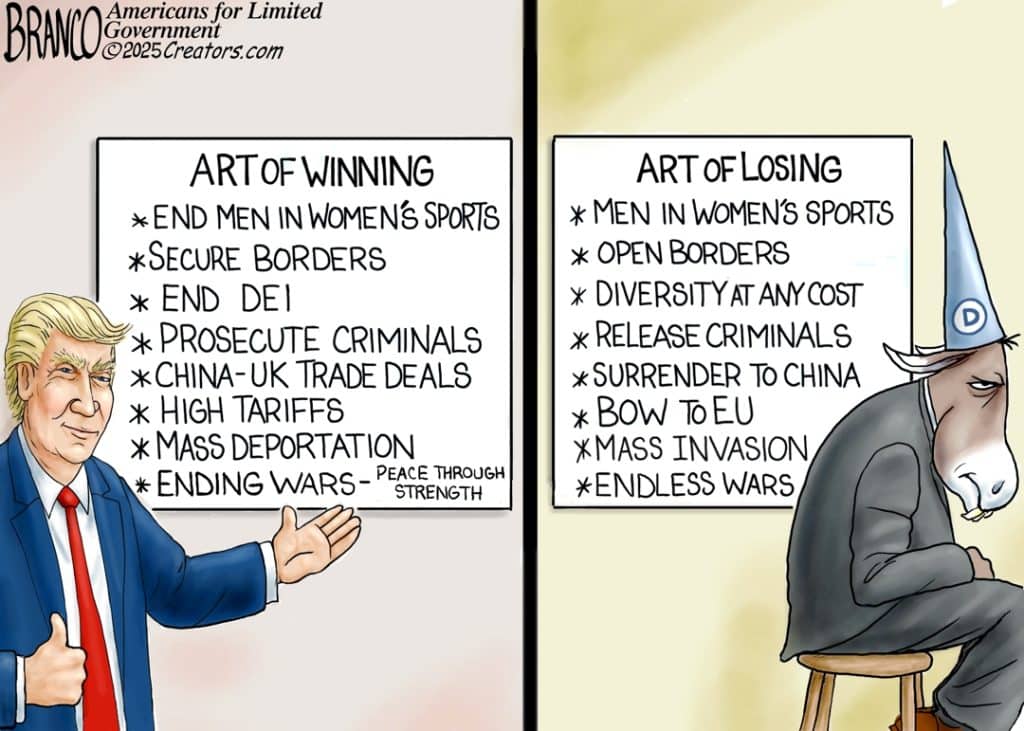
May 13, 2025
Permission to republish original opeds and cartoons granted.
Winning: Inflation Slowed To 2.3 Percent In April, Lowest Since February 2021 Despite Tariffs
|

|
|
The annual consumer inflation rate for April slowed down to 2.3 percent, the lowest since February 2021, according to the latest data compiled by the Bureau of Labor Statistics, despite the imposition of reciprocal tariffs by President Donald Trump on April 2 that all of Washington, D.C.’s experts arrogantly projected would increase prices. Food at home down 0.1 percent. Food away from home down 0.4 percent. Gasoline down 0.1 percent. Fuel oil down 1.3 percent. Apparel down 0.2 percent. New vehicles unchanged. Used cars and trucks down 0.5 percent. So much for that. In the meantime, the tariffs were successfully utilized by the President to spearhead trade negotiations with countries all over the world, already resulting in reciprocal trade agreements with the United Kingdom and China, in the latter case, lowering reciprocal tariffs, which again, all of the experts stated was impossible. Democrats who foolishly hitched themselves to the wagon that inflation would go accelerate from tariffs are now careening down the mountainside of false predictions — along with prices. Now that tariffs are reciprocally being lowered, what will their next prediction be? Who cares? The chicken little doomsaying by the President’s tariff opponents have at least created one bit of certainty for markets — that those opponents are likely to be wrong.
|
U.S.-China Trade Deal Thanks To Trump’s Art Of The Deal, Tariffs Higher Than In 2024
|

|
|
Americans for Limited Government Executive Director Robert Romano: “This is President Trump’s art of the deal. As the country with the $295 billion trade deficit, vis a vis China, the U.S. always had all the leverage in the negotiation over tariffs — if only there was a president with the strength to use it… Originally, President Trump’s tariffs on China from the first administration that former President Joe Biden never rescinded were 25 percent on $250 billion of goods and another 7.5 percent on all the remaining $300 billion of goods. Upon assuming office on January 20, President Trump instituted an additional 10 percent tariff to encourage help on stopping the deadly fentanyl trade on February 1, which was raised to 20 percent on March 3. On April 2, the reciprocal tariff rate was then set to 34 percent. Afterward, China retaliated big time and so President Trump again raised the reciprocal tariff to 84 percent on April 8 and then to 125 percent on April 9. Combined with the fentanyl tariff, that brought the total tariff to 145 percent — and brought China to the table. Now, under the new trade agreement, the baseline reciprocal tariff has been lowered to 10 percent, the 20 percent fentanyl tariff is remaining in place and so are the 25 percent tariffs on $250 billion of goods and 7.5 percent on the remaining $300 billion of goods. They’re all being added together — and China agreed to this.”
|
Winning: Inflation Slowed To 2.3 Percent In April, Lowest Since February 2021 Despite Tariffs

By Robert Romano
The annual consumer inflation rate for April slowed down to 2.3 percent, the lowest since February 2021, according to the latest data compiled by the Bureau of Labor Statistics, despite the imposition of reciprocal tariffs by President Donald Trump on April 2 that all of Washington, D.C.’s experts arrogantly projected would increase prices.

Food at home down 0.1 percent.
Food away from home down 0.4 percent.
Gasoline down 0.1 percent.
Fuel oil down 1.3 percent.
Apparel down 0.2 percent.
New vehicles unchanged.
Used cars and trucks down 0.5 percent.
So much for that.
In the meantime, the tariffs were successfully utilized by the President to spearhead trade negotiations with countries all over the world, already resulting in reciprocal trade agreements with the United Kingdom and China, in the latter case, lowering reciprocal tariffs, which again, all of the experts stated was impossible.
In his May 7 press conference, Federal Reserve Chairman Jerome Powell who has been holding interest rates high while the rest of the world is cutting could not decide if tariffs would cause inflation to be a one-time spike, or a prolonged affair: “The effects on inflation could be short-lived, reflecting a one-time shift in the price level. It is also possible that the inflationary effects could instead be more persistent. Avoiding that outcome will depend on the size of the tariffs … on how long it takes for them to pass through fully into prices and ultimately on keeping longer term inflation expectations well anchored.”
How about price increases would not accelerate at all? It did not even cross Powell’s mind. The only possibilities were up a lot, once, or up a lot for a long time.
But as President Trump is apt to note, Powell is always late to the party. So, the central bank’s tendency to fight the last war is actually rather predictable.
And yet, this was exactly what Trump had done in his first term, using threatened tariffs in 2019 against Mexico to achieve Remain in Mexico, secure that country’s military cooperation in policing the U.S. southern border and eventually the U.S.-Mexico-Canada trade agreement.
And Trump used actual tariffs against China in 2018 to bring China to the table for what became the January 2020 trade agreement.
All while having record low inflation.
In other words, President Trump has a very clear history of using tariffs to begin trade negotiations, resulting real trade deals that you can point to, without runaway inflation (or any at all for that matter) but none of the so-called experts could foresee that exactly the same thing would happen here.
The only item up significantly was natural gas at 3.7 percent, but not because of tariffs, rather, natural gas prices were already spiking in March as a result of weather, supply constraints and demand.
Democrats who foolishly hitched themselves to the wagon that inflation would go accelerate from tariffs are now careening down the mountainside of false predictions — along with prices.
The fact is, inflation has been slowing for almost three years now and usually finds its bottom following an economic recession or slowdown.
Now that tariffs are reciprocally being lowered, what will their next prediction be? Who cares? The chicken little doomsaying by the President’s tariff opponents have at least created one bit of certainty for markets — that those opponents are likely to be wrong.
Robert Romano is the Executive Director of Americans for Limited Government Foundation.
To view online: https://dailytorch.com/2025/05/winning-inflation-slowed-to-2-3-percent-in-april-lowest-since-february-2021-despite-tariffs/
Cartoon: Winners And Losers
By A.F. Branco

Click here for a higher level resolution version.
To view online: https://dailytorch.com/2025/05/cartoon-winners-and-losers/

U.S.-China Trade Deal Thanks To Trump’s Art Of The Deal, Tariffs Higher Than In 2024
May 12, 2025, Fairfax, Va.—Americans for Limited Government Executive Director Robert Romano today issued the following statement congratulating President Donald Trump, U.S. Treasury Secretary Scott Bessent, U.S. Trade Representative Ambassador Jamieson Greer, the Trump administration and the Chinese trade delegation on the successful negotiation of the new U.S.-China trade agreement:
“This is President Trump’s art of the deal. As the country with the $295 billion trade deficit, vis a vis China, the U.S. always had all the leverage in the negotiation over tariffs — if only there was a president with the strength to use it. By courageously raising tariffs as high as 145 percent, President Trump forced that negotiation to occur, showing leadership at a time others would have surrendered. As it turned out, China needed a deal more than the U.S. did. All the U.S. needed was patience.
“Originally, President Trump’s tariffs on China from the first administration that former President Joe Biden never rescinded were 25 percent on $250 billion of goods and another 7.5 percent on all the remaining $300 billion of goods. Upon assuming office on January 20, President Trump instituted an additional 10 percent tariff to encourage help on stopping the deadly fentanyl trade on February 1, which was raised to 20 percent on March 3. On April 2, the reciprocal tariff rate was then set to 34 percent. Afterward, China retaliated big time and so President Trump again raised the reciprocal tariff to 84 percent on April 8 and then to 125 percent on April 9.
“Combined with the fentanyl tariff, that brought the total tariff to 145 percent — and brought China to the table.
“Now, under the new trade agreement, the baseline reciprocal tariff has been lowered to 10 percent, the 20 percent fentanyl tariff is remaining in place and so are the 25 percent tariffs on $250 billion of goods and 7.5 percent on the remaining $300 billion of goods. They’re all being added together — and China agreed to this. The tariffs are therefore now still higher than they were prior to January 20. And if China does not honor the deal or if the negotiations go south, the tariffs can always go higher again.”
To view online: https://getliberty.org/2025/05/u-s-china-trade-deal-thanks-to-trumps-art-of-the-deal-tariffs-higher-than-in-2024/
